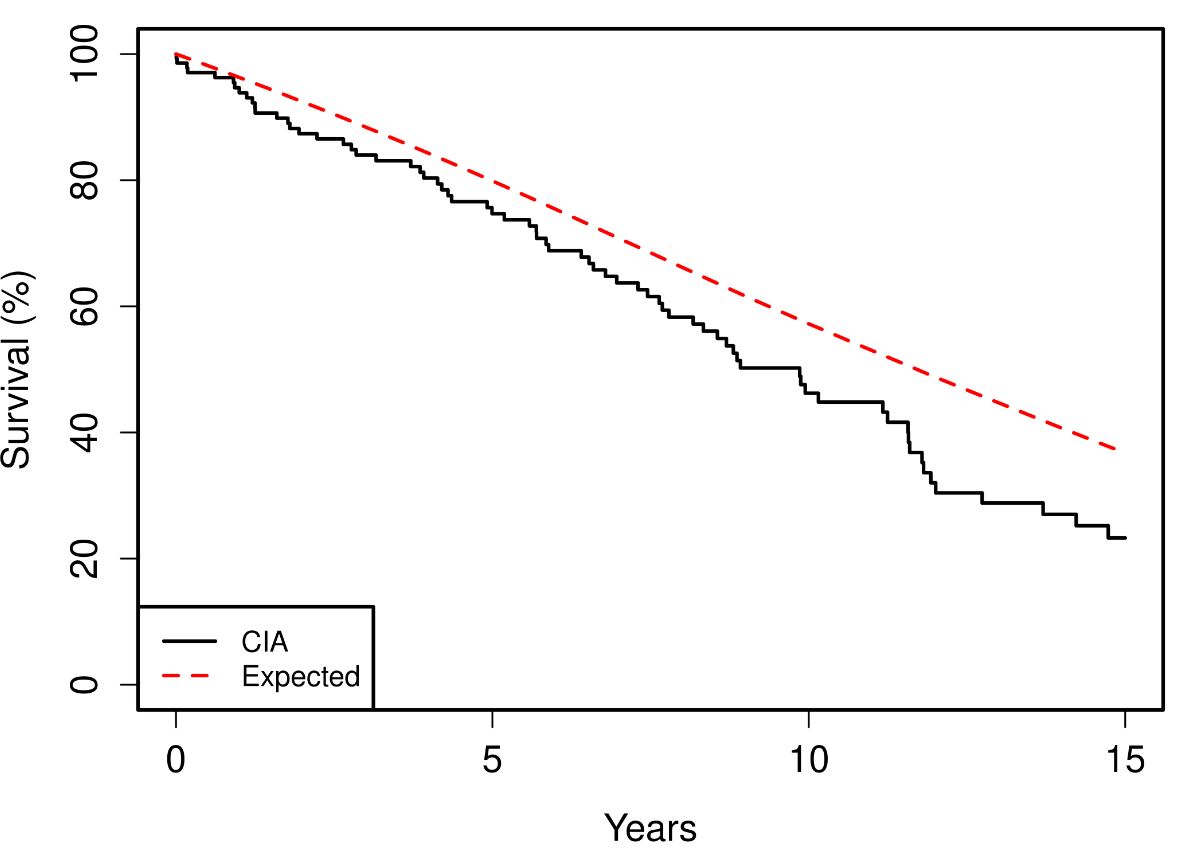Session Information
Date: Monday, November 18, 2024
Title: Vasculitis – Non-ANCA-Associated & Related Disorders Poster III
Session Type: Poster Session C
Session Time: 10:30AM-12:30PM
Background/Purpose: Clinically Isolated Aortitis (CIA) is a type of vasculitis affecting the aorta in the absence of systemic vasculitis, rheumatic disease, or infection. Most patients are diagnosed incidentally after aortic aneurysm resection, and optimal management remains unclear. The aim of this study was to investigate the clinical characteristics and outcomes of patients with CIA diagnosed at a tertiary referral center.
Methods: All patients who underwent thoracic aorta surgery between 2000 and 2021 were identified using procedure codes. Histopathological examination reports of the aortic tissue of all patients were manually reviewed. Patients with CIA were required to be above age 50 years and have active aortic inflammation in the absence of any previous diagnosis of systemic vasculitis, rheumatologic disease, or infection. Patients with active cancer within the preceding year prior to the index aortic operation were excluded. Patients were followed-up through December 31, 2021. Kaplan-Meier methods and Cox models were used.
Results: We included a total of 141 patients with CIA. Mean (Standard Deviation [SD]) age at the time of index aortic surgery was 73.7 (7.25) years, and 77 (55%) were female. Most patients (90, 64%) did not have any signs or symptoms attributed to their aortopathy prior to surgery. Mean (SD) size of the ascending aorta at the time of aortic surgery was 5.8 (0.79) cm. Inflammatory markers were within reference ranges pre-operatively (Mean [SD] erythrocyte sedimentation rate: 10.1 [7.85] mm/hour, mean [SD] C-reactive protein: 4.8 [2.87] mg/L).
Histopathological examination revealed giant cells in most patients (105, 74%). Sixty-seven (48%) patients had at least one vascular abnormality in a location other than aorta at the time of index aortic surgery. Ninety-five (67%) patients were evaluated by a rheumatologist after the index aortic surgery. Median (Interquartile Range) duration of follow-up was 5.9 (2.2- 9.9) years, and 45 were treated with glucocorticoids (GCs) during follow-up. An estimated 33.1% received GCs in the first year and 37.2% received GCs by 5 years. The median duration of treatment with GCs was 1.65 (95% Confidence Interval [CI]: 1.23-2.68) years.
The cumulative incidence of the development of new vascular abnormalities in a location other than the aorta at 5 years was 22.1% (95% CI: 12.5- 30.7%). Cumulative incidence of vascular re-operation after the index aortic surgery at 7 years was 9.5% (95% CI: 3.2- 15.3%).
Patients with CIA had increased mortality compared to age and sex matched total United States population, with a standardized mortality ratio of 1.33 (95% CI: 1.04- 1.66, p: 0.014) (Figure 1).
Postoperative GCs usage was neither associated with overall mortality (Hazard Ratio: 0.93, 95% CI: 0.56-1.54) nor with risk of re-operation (Hazard Ratio: 1.34, 95% CI: 0.43- 4.22).
Conclusion: This is the largest cohort of patients with CIA reported to date. Vascular abnormalities often extend beyond the resected aorta, and the role of glucocorticoid treatment in this disease remains unclear. Patients with CIA are at increased risk of mortality, underscoring the need for a better understanding of disease pathogenesis.
To cite this abstract in AMA style:
Kaymakci M, Langenfeld H, Hanson A, Crowson C, Bois M, Schaff H, Elfishawi M, Koster M, Weyand C, Warrington K. Clinical Characteristics and Outcomes of Patients with Clinically Isolated Aortitis [abstract]. Arthritis Rheumatol. 2024; 76 (suppl 9). https://acrabstracts.org/abstract/clinical-characteristics-and-outcomes-of-patients-with-clinically-isolated-aortitis/. Accessed .« Back to ACR Convergence 2024
ACR Meeting Abstracts - https://acrabstracts.org/abstract/clinical-characteristics-and-outcomes-of-patients-with-clinically-isolated-aortitis/

